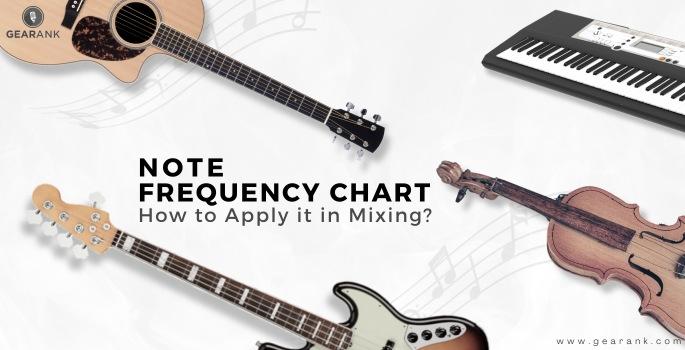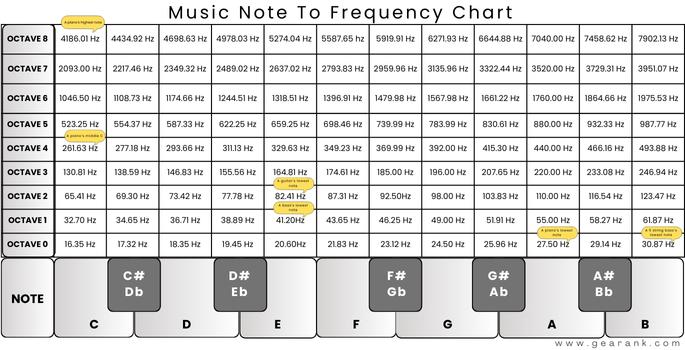Note Frequency Chart: How to Apply It in Mixing

Throughout millennia, music innovators tried to figure out ways to categorize pitches in a way that it's in harmony with other notes. Some have used mathematical ratios by cutting metal bars or wood, while others used different tensions by ear to tune pianos or guitar strings. These days people use convenient tools like a note frequency chart.
How can a sound engineer benefit from knowing note frequencies? Knowing the fundamental frequency of each of your instruments will make it easier for you to mix your songs.
Tune in to this article. I'll explain the details:
-
How is frequency calculated?
-
How did we arrive at note frequencies?
-
Note Frequency Chart
-
How does it help in mixing?
-
How did we arrive at note frequencies?
-
Summary
What Is Note Frequency & How Is It Calculated?
Let’s suppose we don’t have prior knowledge of notes, and all we have are sounds. We know intuitively that there are high sounds and low sounds. How do we differentiate between them?
We calculate them by measuring them in hertz (Hz)--It is the basic unit of frequency measurement.
A sound wave goes through a positive and a negative state. One vibration per second is equal to 1 Hz. Electric tuners and tonometers measure the oscillation of the waves of an individual sound, and they project the overall value in Hz.
For instance, if you take a digital tuner and play A above middle C, it will show 440 hz. Therefore, the A note cycles at 440 times each second.
Note Frequency Chart
Without further ado, you can find the frequency chart below. Each note has its corresponding frequency. This can be used as a reference for mixing.

This chart is based around the collection of pitch frequencies from a 12-note equal-tempered scale (more about this later). Here you can see that the instruments are plotted based on their highest and lowest frequencies. The limits of human hearing is only from 20hz-20kHz. 16.35 Hz was plotted here to show how it looks like theoretically.
How does it help in mixing?
The end goal of audio engineering is to make each instrument sound as musical as possible. Besides the technicalities of mixing and mastering, it's an art in and of itself.
1. Harmonics
Sounds occupy certain spaces in the frequency spectrum. If you have a general idea of which chords the guitar is playing, say hovers around the fundamental frequency of 185.00-369.99 Hz, you can easily determine which resonant frequencies can be cut, retained, or boosted.
2. Clean Up
It takes away the guesswork of cleaning up instruments. Since you know the musical notes are playing around a certain range, you can isolate those and cut the ones you don't need.
For instance, you have a guitar and a vocal. Each is playing at specific ranges of frequency. You want to retain the low notes of the guitar and do a low cut for the vocals. Mid frequencies of both can clash together but you hear the vocals.
3. Shaping low end and percussions
In electronic music, tuning instruments such as the 808 bass in key makes the beats sound fuller. Here, the fundamental frequency matters as both instruments occupy the low end.
What does a music producer do when faced with these challenges? They play a crucial role in ensuring instruments are tuned to the song's key signature, enhancing the overall sonic experience.
At worst, phase cancellations can make their sounds weaker. This could be solved by tuning them in the key of the song and EQing them. High-sounding percussions would also sound better if it's tuned to the song's key signature.
How did we arrive at note frequencies?
The events that led to note frequencies can be summarized as:
Musicians playing around with sound-->Experimentation with intuitive tuning systems-->Invention of equal temperament-->Note frequency standardization.
Throughout the remainder of history, musicians have calibrated their instruments by ear. Knowing which collection of pitches sounds harmonious to the other is determined by intuition.
They discovered that the sounds of two adjacent notes have to be spaced far enough to sound pleasant (consonance). If they're too near it would produce dissonance.
To solve this, a tuning system has to be created. This is why we now use a standard tuning system called the twelve-notes tuning system. This is also known as equal temperament.
The human ear is sensitive to musical note relationships. This is why we've tuned instruments based on a mathematical frequency ratio. However, for a very long time, we didn't have a specific frequency to tune our instruments in.
Specificity is needed to refine tuning methods. Then in the late 1800s, with technological developments of the tonometer (invented by Johann Scheibler) and the electric tuner, we were able to determine notes frequencies. In 1936, 440 Hz became the standard tuning for instruments.
What is 432 Hz, and how does it relate to music tuning? Exploring alternative tunings has been a subject of interest among musicians and sound enthusiasts, with some claiming benefits and unique qualities associated with the 432 Hz frequency.
Note Frequencies and Equal Temperament
We mentioned equal temperament the standard tuning method for most Western music. This system is widely used in music theory. It conveys that there will be twelve pitches per each octave, with equal spaces between them--hence the term equal tempered scale.
The standard tuning for most instruments will be based on a 440 Hz reference for the note A4, the same note as concert A. This is the reference point for all of the other music notes, and other notes are calculated using mathematical relationships based on the music scale.
Summary
While note frequencies are an integral part of musical theory, having this note frequency chart will streamline your work flow as a sound engineer. Using various applications like cleaning up harmonics and shaping the low end frequencies.
Keep in mind, this chart is meant as a reference point. At the end of the day, your skills of sculpting sound will determine the quality of your work.
Contributors:
Allen Articulo - Co-writer
Jerry Borillo - Illustrator












